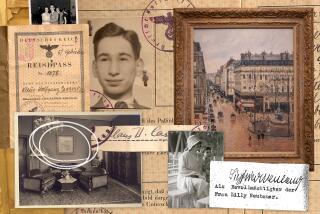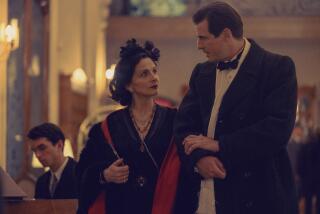Daniel Wildenstein, 84; Art Dealer
Daniel Wildenstein, a French art dealer, collector and scholar whose family built an international empire of prestigious galleries, died Tuesday. He was 84. The Wildenstein Institute, which announced the news, said he had been undergoing treatment at a clinic in Paris but did not disclose the cause of death.
Wildenstein--who distinguished himself as the author of definitive books on Claude Monet, Paul Gauguin and other artists--was the third in a dynasty of wealthy art merchants.
Known as shrewd businessmen with keen eyes for artistic quality, they amassed a vast inventory of Old Master, Impressionist and Postimpressionist works, held on to them until their value had escalated, then parceled them out to leading collectors and museums around the world.
Their American clients include a who’s who of prominent East Coast collectors: J. Pierpont Morgan, Henry Clay Frick, Robert Lehman, Duncan Phillips, and the Kress, Rockefeller and Mellon families.
On the West Coast, Los Angeles industrialist Norton Simon began shopping at Wildenstein & Co. in New York in 1955. His purchases there included Raphael’s “Madonna and Child with Book,” one of the most treasured works at the Norton Simon Museum in Pasadena.
Wildenstein was born Sept. 11, 1917, in Verrieres-le-Buisson, near Paris. He was the son of Georges and Jane Wildenstein and the grandson of Nathan Wildenstein, who founded the family’s lucrative business.
With his career path set in his youth, Daniel Wildenstein was educated at the Sorbonne and took over the family galleries in Paris and London in 1959. He assumed control of the London and Buenos Aires galleries in 1963, the year his father died, and added a gallery in Tokyo in the early 1970s.
The company was a powerful force in the art market throughout his life, but the network of galleries shrank in his later years. Today, the family maintains only two, both in New York: Wildenstein & Co. on East 64th Street and PaceWildenstein on East 57th Street.
PaceWildenstein--a joint venture formed in 1993 with Pace Gallery, a leading New York dealer in contemporary art--opened a high-profile exhibition space in Beverly Hills in 1995, but closed it in 1999. The company maintains only an office--and no public exhibition space--in Southern California.
In plying the high end of the art trade, Wildenstein continued a family tradition that was initiated by an Alsatian textile dealer who switched to fine art with stunning success.
Nathan Wildenstein, who was born in 1851, left Alsace in 1870 and settled in Paris. Sensing the potential for selling artworks to the wealthy bourgeoisie, he first specialized in 18th century French paintings and drawings, then expanded to Italian, Dutch, Flemish and Spanish art.
By the end of the 19th century, he had a huge inventory of European Old Master paintings, sculptures, drawings, furniture and decorative objects, along with an enviable European client list. Eager to secure a large share of the American market, he opened a gallery in New York in 1903. Next came London, where he launched a gallery in 1925.
His son, Georges--who was born in 1892 and started working in the galleries in 1910--introduced a scholarly component to the business.
During his reign, he built an extensive library of art history and photographic archives and compiled complete catalogs of the work of Jean Simeon Chardin, Maurice Quentin de La Tour, Jean Honore Fragonard and Jean-Auguste-Dominique Ingres. He also added Impressionist and Postimpressionist works to his father’s stockpile of Old Masters.
When Daniel took the helm, he continued his father’s scholarship as well as the family business.
He revised and expanded his father’s catalogs and plunged into projects of his own. His art history contributions were recognized in 1971, when he was elected a member of the prestigious Institut de France.
In 1992, when his five-volume work on French Impressionist Claude Monet was published--after 50 years of labor--Wildenstein told an interviewer that “not many fools would finish such a work.” But scholarship continued to be an important part of his life. His book on Paul Gauguin was published the day before he died.
The family reputation has been tarnished by scandals and lawsuits in recent years, most notably involving issues surrounding the Nazis’ confiscation of art during World War II.
A current case in New York, brought by heirs of Jewish collector Alphonse Kann, charges Daniel Wildenstein and his sons Alec and Guy with wrongful possession of eight illuminated manuscripts from the 15th, 16th and 17th centuries.
The suit alleges that the Nazis looted the manuscripts from Kann in 1940; the Wildensteins claim that Georges Wildenstein legally owned the works before he fled France and that records of German ownership are incorrect.
The Wildensteins attempted to clear their name in a related case last year in Paris, but failed.
They had sued art historian Hector Feliciano, whose book, “The Lost Museum: The Nazi Conspiracy to Steal the World’s Greatest Works of Art,” suggests that Georges Wildenstein may have collaborated with the Nazis. The court ruled that it was up to historians and the public to judge allegations in the book.
Wildenstein is survived by his sons, who continue to run the family galleries, and six grandchildren.
More to Read
The biggest entertainment stories
Get our big stories about Hollywood, film, television, music, arts, culture and more right in your inbox as soon as they publish.
You may occasionally receive promotional content from the Los Angeles Times.










